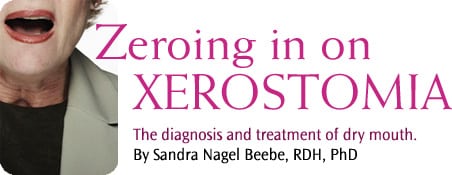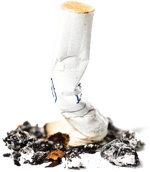
Xerostomia or dry mouth is a common concern in the dental field. In the United States alone, millions of people are affected by it.1-4 The condition may be temporary or permanent.5
|
The main causes of xerostomia are medication use, head and neck cancer treatments, autoimmune diseases or systemic diseases, and salivary gland removal.5,6
Medication use. Over-the-counter and prescription drugs are often the culprits behind xerostomia.1,5 As the number of medications taken increases, so does the risk of xerostomia. The 2000 Report of the Surgeon General indicates that more than 400 drugs can cause xerostomia.4,6-8 Table 1 lists the drugs that most often cause dry mouth symptoms.9 Antihistamines, diuretics, and antidepressants are the three most commonly used types of medications that cause xerostomia.6 Head and neck cancer treatments. Cancer patients receiving head and neck radiation or chemotherapy often experience dry mouth. Treatments may decrease or stop the saliva flow due to inflammation or the saliva gland’s inability to function.6 During treatment, major and minor salivary glands are injured or damaged from ionizing radiation, which causes atrophy of the secretory components and produces temporary or permanent xerostomia.2
Autoimmune/ systemic diseases. Various systemic diseases and conditions impact dryness in the oral cavity. Patients with xerostomia symptoms may have an underlying disease that is not being treated like Sjogren’s syndrome, diabetes mellitus, Parkinson’s disease, hypo- and hyper-thyroidism, adrenal cortex disease, renal disease, alcoholic cirrhosis, cystic fibrosis, Bell’s palsy, sarcoidosis, amyloidosis, graft-versus-host disease, depression, HIV/AIDS, nutritional deficiencies, and eating disorders and malnutrition (anorexia, bulimia, dehydration).1,2,5,6,10
People who breath through their mouths may experience dry conditions that lead to the inflammation of gingival tissues—changing the size, shape, surface textures, and consistency.5 Saliva reduction is also influenced by stress, anxiety, eating a soft food diet,2,11 or drinking caffeinated products.1 Recreational drugs, especially methamphetamines and ecstasy (amphetamines, barbiturates, and benzodiazepines), also cause xerostomia.5,9
Salivary glands. Patients who have had their salivary glands removed will definitely experience xerostomia.5 Saliva flow may also be stopped or decreased through mechanical blockage or salivary stones (sialolithiasis). The submandibular gland is the most common location.7
Diagnosis
Determining if a patient has xerostomia is important because changes in the flow of saliva can have far reaching oral health implications. Following is a series of suggested questions to ask patients whom you suspect may be experiencing dry mouth:1,12
- How long have you been experiencing the pain/condition and how often?
![]()
- What prescription or over-the-counter medications or supplements/vitamins are you taking?
- Do you frequently moisten your mouth or lips?
- How much water are you consuming on a daily basis?
- At mealtime, do you have difficulty swallowing or chewing dry foods?
- Do you have any chronic diseases or conditions, eg, Sjogren’s syndrome, diabetes, hypertension, depression, anxiety?
- When was your last complete physical examination? Dental examination?
- How often do you brush?
- Do you have toothaches, pain, or sores on your lips or inside your mouth?
- Do you wear dentures or partials? How often do you clean them?
- Have you had head or neck cancer therapy?
- Have your salivary glands been removed?
The following guidelines can also help dental hygienists identify the presence of xerostomia: acquiring a health history, oral examination, determining saliva flow rate, scintigraph/scintiscan, and biopsy of minor salivary glands.1,13
In reviewing the health history, the duration, frequency, and severity of dry mouth needs to be ascertained. Other notable sites to question include: eyes, nose, throat, skin, and vagina. A thorough health history includes a list of the medications and over-the-counter drugs being used by the patient.13
During a health history, the salivary glands should be palpated to observe tenderness, firmness, swelling, and the amount of saliva dispersed or not dispersed. Observe if the color is red or if the oral mucosa has a dry appearance.13
|
|
|
1. Change medication regimen |
A saliva flow test should be administered to determine the amount of saliva flow during a given time period. Two saliva tests available are Saliva Check* and CRT buffer caries risk test,** which take approximately 10-15 minutes and provide immediate results. Saliva results include stimulated and unstimulated flow levels, consistency, quantity, pH, and buffering capacity. Another type of saliva test, the CRT bacteria test**, requires 48 hour incubation period from the saliva sample. Check stimulated and unstimulated saliva flow because results may indicate a saliva gland pathology.13,14
The scintigraph is an in-hospital, invasive procedure used to determine saliva flow through a procedure using small amounts of injectable radioactive material taken up by blood from salivary glands and secreted into the mouth.13 Scintigraphs are excellent for observing salivary function and changes in salivary dysfunction, eg, salivary stones (sialoliths), duct blockage, constriction or damage, tumors, and cysts.1
The most invasive procedure for diagnosing saliva gland malfunction is the biopsy of minor salivary glands located in the lower lip.1,13 Specifically, the labial minor gland is the best for examining characteristic changes of Sjogren’s syndrome.1,12,13
TREATMENT
Treatment will vary according to the various causes. When caused from medications, the medication regimen should be altered.13 General recommendations for xerostomia relief are suggested in Table 2.5,15 Conferring with the patient’s physician should be considered when xerostomia is due to systemic problems.
When dry mouth occurs, extra steps are necessary for proper oral care. Patient care should include: brushing gently for a minimum of twice daily, flossing, fluoridated toothpaste (or amorphous calcium phosphate, Novamin®, or Recaldent® for demineralization), rinsing/ brushing with fluoride gels, use of fluoride custom trays, avoiding sticky sugary foods or brushing immediately, regular appointments with an oral health care professional,9,15,16 and breathing through thenose.16
SALIVA SUBSTITUTES

Artificial saliva will reduce xerostomia for short periods of time. Saliva stimulants are available by prescription (pilocaine and cevimeline). These provide relief for several hours. However, they do come with side effects and they may cause tooth decay.13 Also available are fluoride gels and liquids. Commercial products are available in mouthrinses, sprays, solutions, gels, and lozenges.12 Chlorhexidine and antifungal agents may reduce related infections.1,7,9 Chewing gum helps stimulate the saliva causing an increased saliva flow. Other product materials to stimulate saliva flow are available such as mints, candies, and liquids.14
CONCLUSION
A salivary function assessment should be part of providing intraoral examinations. Patients need not suffer with dry mouth with no relief. Products have become more accessible and user friendly and oral lubricants and saliva substitutes are becoming more available. Patients need to also be advised on how xerostomia relates to their overall health and what they need to do to control it and prevent it from causing other problems. Dental professionals can definitely make a difference in patients’ overall and oral health in regard to dry mouth.
REFERENCES
- Fox PC. Xerostomia: recognition and management. Access. 2008;22(2)(Suppl):1-7.
- Guggenheimer J, Moore PA. Xerostomia etiology, recognition and treatment. J Am Dent Assoc. 2003;134:61-69.
- Streebny LM, Valdini A. Xerostomia: a neglected symptom. Arch Intern Med. 1987;147:133-137.
- Steenbny LM, Schwartz SS. A reference guide to drugs and dry mouth. Gerodontology. 1997;14:33-47.
- Wilkins EM. Clinical Practice of the Dental Hygienist. 10th ed. Baltimore: Lippincott Williams & Wilkins; 2009: 256, 260, 392-393, 403, 542, 824, 839, 860.
- American Society of Aging. CDC aims to prevent oral diseases among older Americans. Available at: www.asaging.org/media/pressrelease.cfm?id=85. Accessed October 22, 2008.
- Hupp WS. Xerostomia. Available at: www.dentaleconomics.com/display_article/319676/76/none/none/Healt/Xerostomia?host=www.wdjournal.com. Accessed October 22, 2008.
- Oral Health in America: A Report of the Surgeon General. Rockville, Md: US Department of Health & Human Services, National Institute of Dental and Craniofacial Research, National Institute of Health; 2000:32, 51, 107.
- Darby ML, Walsh MM. Dental Hygiene Theory and Practice. 2nd ed. St. Louis: Saunders; 2003:195-197,883-901.
- Delaleu N, Immervoll H, Cornelius J, Jonsson R. Biomarker profiles in serum and saliva of experimental Sjogren’s syndrome: associations with specific autoimmune manifestations. Arthritis Res Ther. 2008;10:R22.
- Alty CT. The wonders of spit. RDH. 2003;23(6):1-3.
- Bartels CL. Xerostomia information for dentists. Available at: www.oralcancerfoundation.org/dental/xerostomia.htm. Accessed October 22, 2008.
- Sjogren’s Syndrome Foundation. Dry mouth: A hallmark symptom of Sjogren’s syndrome. Available at: www.sjogrens.org/syndrome/dry_mouth.html. Accessed October 22, 2008.
- Nieves A, Fitzgerel-Blue W. Saliva: Of emerging importance in the medical and dental worlds. RDH. 2008;28(5):46-52.
- National Institute of Dental and Craniofacial Research. Dry mouth. Available at: www.nidcr.nih.gov/OralHealth/Topics/DryMouth. Accessed October 22, 2008.
- Dry mouth causes, symptoms and treatment. Available at: www.medicinenet.com/dry_mouth/article.htm. Accessed October 22, 2008.
From Dimensions of Dental Hygiene. November 2008; 6(11): 40, 42.


